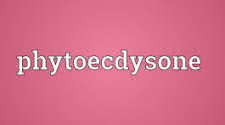Information on Phytoecdysones - Sparing Protein for Bodybuilders

Understanding what Supplements actually Supplement for You is Key
What exactly are phytoecdysones and what is their application to bodybuilders? Phytoecdysones are plant steroids that mimic insect
hormones. They may be valuable to bodybuilders - perhaps substantially so - for their ability to improve protein utilization
efficiency, especially during low-carb dieting.
Right now, the hottest topic in bodybuilding nutrition is insulin manipulation, especially as it applies to enhancing protein
synthesis. Insulin is, after all, the key that opens the gates to allow amino acids and glucose into muscle cells. Once there,
aminos stimulate the building of new muscle proteins and glucose stimulates the synthesis of glycogen.
How, though, do you stimulate insulin secretion when you're on a low-carb diet, especially when you're consuming low-carb protein
drinks? If you take in protein without carbs, your body converts some of the amino acids from that dietary protein into glucose.
This is especially true for whey protein because it doesn't increase insulin significantly. That, in addition to its rapid rate
of digestion and absorption, is why a Huge percentage of whey consumed on an empty stomach is used for energy production instead
of muscle building.
Although it's not the end of the world, such poor protein utilization efficiency can prove not only costly but frustrating,
especially if you think you're getting enough protein but still aren't making any gains. It's also unnecessary, because if you
could bump insulin, efficiency would improve, However, adding carbs to meals and protein drinks to bump insulin - except right
after training - is generally unacceptable to those who are serious about cutting bodyfat.
One approach of some supplement companies is to add insulin secretagogues (certain amino acids and other substances) to their
protein powders in lieu of adding carbs. However, if you raise insulin without providing an external source of glucose, blood
sugar can drop. That hypoglycemia, in turn, can drive up levels of cortisol, which breaks down glycogen and/or proteins to raise
and stabilize blood sugar - a nasty little catabolic cycle, What choice do you have to help your body utilize protein more for
muscle building and less for energy if you opt not to push up carbs or insulin?
One option is to find something that works on the liver, the metabolic center of the body. You'd want something that's potent
and specific enough to partition more dietary amino acids toward protein synthesis than toward glucose production.
Many of the gadgets that can be used to achieve this effect aren't legal, but phytoecdysones are and they appear to be a bona-fide
alternative. Anecdotally, 30-120 milligrams (mg) per day of phytoecdysones with protein produce a decrease in urine urea nitrogen
(UUN). Using pee stick to measure UUN (specifically, the Nitrostix, which was invented by Bob Fritz in 1995 as a "snapshot" method
of measuring UUN), the nitrogen-sparing effect of phytoecdysones is clearly visible. Normally, UUN increases steadily for hours
following a high-protein, low-carb meal. Adding phytoecdysones to the meal produces a color shift on the Nitrostix from green to
not-so-green to yellow, indicating decreased concentration of UUN. That means the nitrogen is being retained (and the protein is
being synthesized) instead of being excreted.
The buzz around phytoecdysones is more than just muscle head anecdotes Research performed in Russia comparable to a mild
anabolic/androgenic drug. The only obvious drawback to phytoecdysones is their cost. The real stuff is expensive - about $7,000
per kilogram. At a dosage of 30-120 mg per day, the cost per month ranges from $25 to $100. As with many supplements, dosage
should probably correspond to bodyweight - the bigger you are, the more is required to produce a beneficial effect. Although
there's no apparent reason for concern, the absence of toxicity data and paucity of human studies are apt to keep a lot of
companies from marketing these substances.
A few multi-component formulations currently being marketed contain various forms of phytoecdysones (you might see
20-hydroxyecdysone or beta-ecdysone, for example), but the dose recommended on those is far below what I believe to be effective.
Be sure about the dosage you're getting, whether you buy it as a single- or multi-ingredient product. Be patient; don't expect
dramatic differences overnight. The effect is subtle, but it is of value over the long haul. It's interesting stuff to put it
mildly.